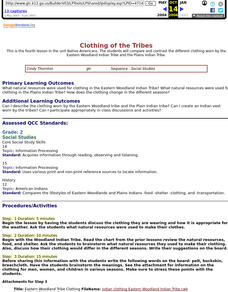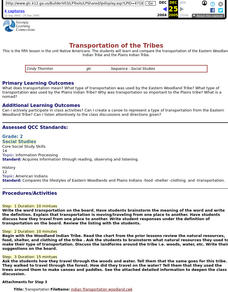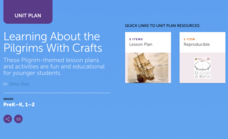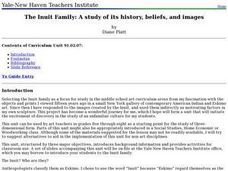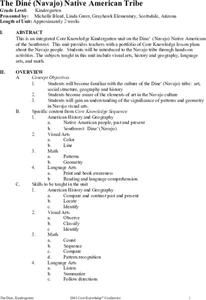Curated OER
Role Models- Grade 9
Ninth graders research Aboriginal role models. In this native studies lesson, 9th graders select leaders of the First Nations and Metis Nations of the Saskatchewan and research their contributions to society. Students create...
Smithsonian Institution
We Have a Story to Tell: Native Peoples of the Chesapeake Region
How did colonial settlement and the establishment of the United States affect Native Americans in the Chesapeake region? Your young historians will analyze contemporary and historical maps, read informational texts, and work in groups to...
Curated OER
The Seven Continents Scavenger Hunt
Who doesn't enjoy an engaging scavenger hunt? Here, scholars listen to, and discuss, the informative text, Where is my Continent? by Robin Nelson. They then explore the seven continents and four major oceans using...
Curated OER
Foreign Miners
Students examine primary source documents from miners who went to California in the search of gold. They compare and contrast the letters they read and discuss what types of discrimination still exists today.
Curated OER
Clothing of the Tribes
Second graders compare and contrast the different clothing worn by the Eastern Woodland Indian Tribe and the Plains Indian Tribe.
Curated OER
Thanksgiving and Agriculture
Students listen to the book "The Pilgrim Story" and discuss the Pilgrims and why they came to America. Students role play the Thanksgiving story and write about how Pilgrims and Indians relate to them today.
Curated OER
Black Hawk and the Black Hawk Trail
Fourth graders investigate the American Indian tribe of Black Hawk and its trail. They use computers and a variety of technology resources to find information and put together a multimedia presentation. The end result is a storyboard...
Curated OER
The First North Americans
Students identify and interpret the different North American Indian groups, by region, and the type and impact of their interaction with Europeans.
Then they complete an overview of one main Native American group during the age of...
Curated OER
Transportation of the Tribes
Second graders compare the transportation system of the Eastern Woodland Indian Tribe and the Plains Indian Tribe. They use a chart imbedded in this lesson to further their understanding of the Plains Indians, then engage in a craft...
Curated OER
Bison on the Plains
Fifth graders explore U.S. geography by reading assigned text about American Indians. In this migration lesson, 5th graders identify the differences between Native Americans and European settlers who traveled through middle America in...
Scholastic
Learning About the Pilgrims With Crafts
Students research the pilgrims in terms of why they left England, their voyage to America, the challenges they faced when they arrived, and their relationship with the American Indians. To conclude this unit, the students have a...
Curated OER
The Lewis and Clark Expedition
Learners explore the challenges of the Lewis and Clark Expedition through a physical education simulation. In this cross-curriculum physical education lesson, students work in groups of three to log 8000 steps, stopping to participate in...
Curated OER
Island of the Blue Dolphins Jigsaw
Fourth graders research three topics from the book, either Village Life, Sea Life, or San Nicholas Island. They research independently and meet in a jigsaw format to share what they learned. As group they create a poster for class...
Curated OER
Predator Protector Game
Students take on the role of an Ocean Adventures expedition volunteer member and are charged with protecting three species of sharks from danger in order to defend the balance of nature in the ecosystem. They play an online game which...
Curated OER
The Good, The Bad, and the Arctic
Students investigate the social, economic and environmental consequences that might result from Arctic climate change. Students identify and discuss at least three consequences.
Curated OER
They Called Him Sequoyah
Young scholars become familiar with George Gist and his life as a Cherokee. In this Cherokee lesson, students research the ways people have communicated in the past and presently. Young scholars recognize that better...
Curated OER
A Hunting We Will Go
Students navigate the Internet to research online encyclopedias and answer questions. In this navigating the net lesson, students answers questions and compare their answers. Students discuss information gathered and the sources....
Curated OER
Cinco de Mayo
Students identify three celebration activities participated in Cinco de Mayo and explain their significance.
Curated OER
The Inuit Family: A study of its history, beliefs, and images
Students study the Inuit in terms of their geographic location and its influence on their way of life. They investigate Inuit imagery as a reflection of their belief system and focus on the objects of the Inuit to introduce...
Curated OER
The Díne (Navajo) Native American Tribe
Students participate in a variety of activities to become familiar with the Navajo Indians. In this Díne (Navajo) Native American tribe lesson, students understand where the Navajo tribe lived and find them on a map. Students discuss the...
Curated OER
Tracking Narwhals in Greenland The Ocean Unicorn
Learners study the ecology, habitats, geographic range and feeding habits of narwhals. They determine at least three reasons for the decline in the narwhal populations and complete the accompanying worksheets.
Curated OER
Turkey Bowl
Rolling three strikes in bowling is known as a turkey—but in a Thanksgiving-themed bowing game, every pin is a turkey! Young learners practice hand-eye coordination, ball rolling, and weight transfer with an engaging game of Turkey Bowl.
Curated OER
Council Grove: Site of the Hellgate Treaty
Young scholars explore Native Americans and the migration of non native people to Montana. They investigate and interpret maps for information such as location of Indian reservations, transportation routes and important communities.
Curated OER
Quality of Information: Point of View and Bias
Fifth graders identify stereotypes of Indian people based on perceived characteristics. They discuss the misconceptions. Students define quality of information and give an example from the story "Seaman's Journal: On The Trail With Lewis...
Other popular searches
- Wampanoag Indians Grade 3
- Vamping Indians Grade 3
- 3rd Grade California Indians
- 3rd Grade Koasati Indians
- 3rd Grade Kasai Indians




